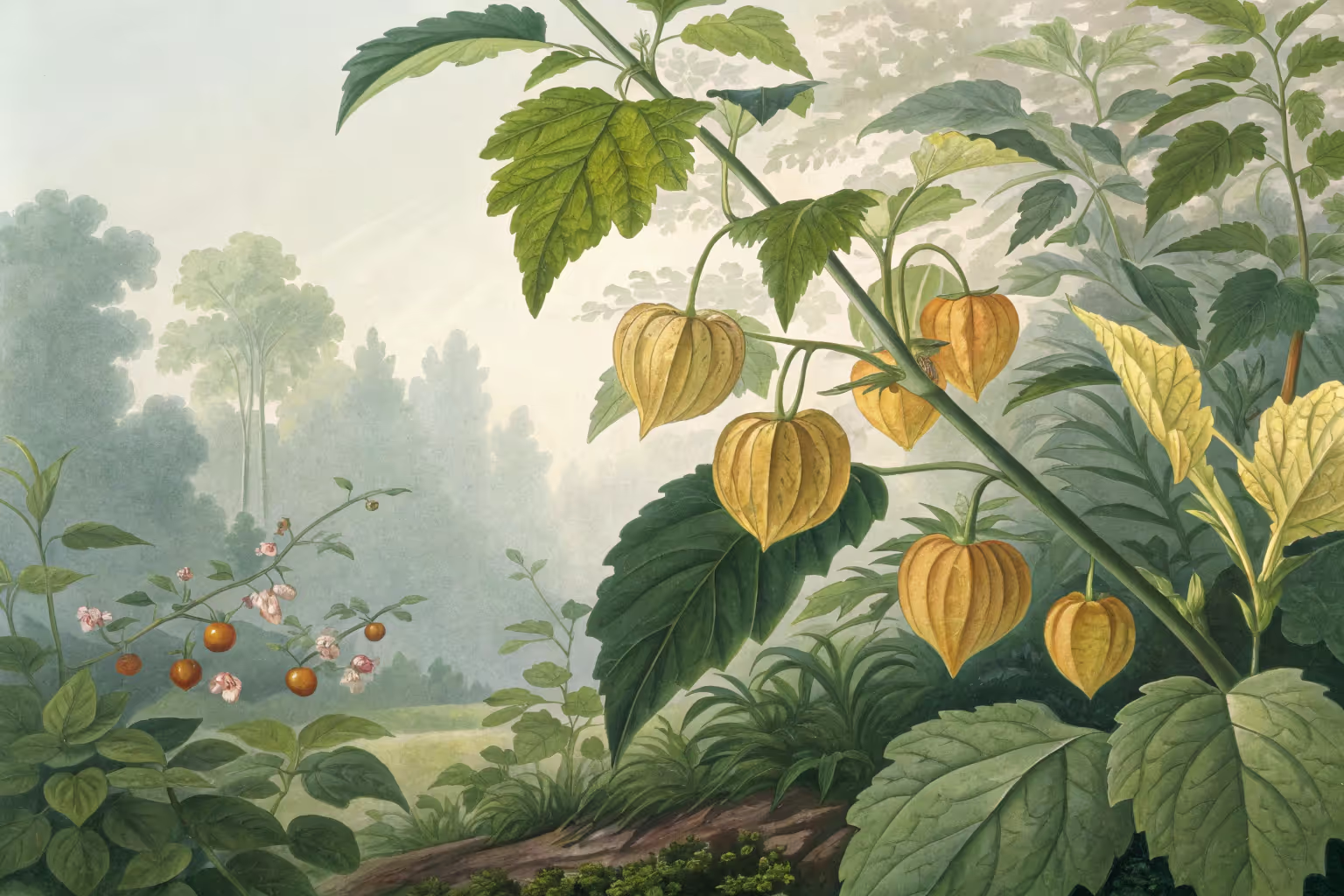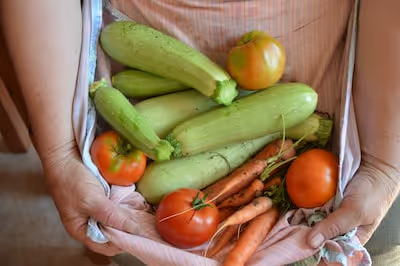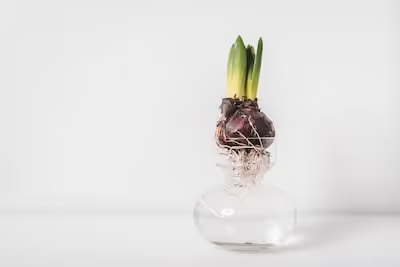Growing Ground Cherries for a Sweet, Abundant Harvest

Growing Ground Cherries
Growing ground cherries puts an enticing, easy-to-cultivate heirloom on your seasonal radar. Sow seeds directly after frost, choose an area basking in full sun, and keep soil reliably moist for tasty harvests in 70–75 days. With papery husks and tangy berries that taste like pineapple-meets-tomato, ground cherries reward gardeners willing to wander beyond the familiar tomato and pepper beds.
Cheatsheet: Quick Start Guide to Homegrown Ground Cherries
🌱 Variety Selection
Aunt Molly’s and Pineapple types yield the sweetest, most reliable fruit. Each plant can produce 300+ fruit.
🔪 Tools and Products You'll Need
- Hand trowel
- Tomato cage or stake
- Quality compost or aged manure
- Mulch (straw or leaf)
- Ground cherry seeds or seedlings
- Pruning shears
- Harvest basket
☀️ Site & Soil
- Full sun (6+ hrs daily)
- Rich, well-drained loam
- pH 6.0–6.8
- Space 24–36 in (60–90 cm) apart
🌡️ Planting Steps
- Start indoors 6–8 weeks before last frost, 70–80°F (21–27°C).
- Transplant outside after danger of frost, soil 60°F (16°C)+.
- Plant deep, up to first leaves for sturdy growth.
- Mulch to retain moisture and suppress weeds.
- Stake or cage for support.
💧 Water & Feed
- Water 1 in (2.5 cm) per week
- Feed monthly with balanced organic fertilizer
🍒 Harvest & Storage
- Harvest when husks turn straw-colored and fruit drops
- Store in husk, cool and dry, 2–3 weeks
- Enjoy fresh, in jams or baked treats
🦠 Health & Nutrition
- High in vitamin C, fiber, antioxidants
- Low calorie, supports immunity and digestion
🌾 Self-Sufficiency Perk
Prolific, low-maintenance fruit extends local food season. Perfect for small spaces.
Growing Ground Cherries for a Sweet, Abundant Harvest
I grow ground cherries like a candy crop with a field habit, and they reward me with baskets of golden lanterns. They taste like pineapple kissed a vanilla bean, then asked a tomato for directions.
Botany, flavor, and the husk that makes them magic
Physalis pruinosa is the common backyard ground cherry, while Physalis peruviana is the taller Cape gooseberry seen in pastry cases. Both wear a papery calyx that protects fruit from pests and rain splash, which helps keep the fruit clean and sweet.
The plants sprawl low, set hundreds of small fruits, and ripen from green to gold inside that husk. I treat them like a compact, ground-hugging cousin of tomatoes.
Seed to transplant: quick, reliable starts
- Sow 6 to 8 weeks before your last frost date at 75 to 85 F, 24 to 29 C, for fast germination.
- Use a fine, sterile mix, then pot up to 3 to 4 inch, 7.5 to 10 cm, containers once true leaves appear.
- Give 14 to 16 hours of light and a steady breeze from a fan to build stocky stems.
- Harden off for 7 to 10 days; transplant after nights hold above 50 F, 10 C, and soil sits at 60 F, 16 C.
Soil prep, spacing, and fertility that drive fruit
They thrive in loose loam with pH 6.0 to 6.8 and moderate fertility, so I work in 1 to 2 inches, 2.5 to 5 cm, of compost and a light dose of balanced 5-5-5. Too much nitrogen grows a jungle with fewer lanterns.
Space plants 18 to 24 inches, 45 to 60 cm, and rows 3 to 4 feet, 0.9 to 1.2 m, since they sprawl. Black mulch or straw keeps fruit clean and speeds ripening.
Water, heat, and season cheats
Give a steady 1 inch, 25 mm, of water weekly and avoid drought swings that cause drop. In cool springs I lay black film and use low tunnels until bloom, which adds early heat.
They set across a wide temperature range, yet soil warmth is your throttle. Warm feet, happy fruit.
Pollination, training, and light pruning
Flowers are self fertile, although bees spike fruit set, so pull covers when blossoms open. I corral plants with low tomato hoops or a short fence to keep fruit off soil.
Pinch the tip once at 10 to 12 inches, 25 to 30 cm, to encourage branching, then let them do their thing. No heavy pruning needed.
Harvest signals and storage that pays
“Ground cherries are ready when the husk dries and fruit falls to the ground.” University of Minnesota Extension
Expect 70 to 80 days from transplant for P. pruinosa, a bit longer for Cape gooseberry. I shake plants lightly and gather the drop daily, then sort out any green stragglers.
Store fruit in the husk at 50 to 60 F, 10 to 16 C, with good airflow and they hold for 2 to 3 weeks. Cape gooseberry keeps even longer at cool room temperatures.
Yield and flavor tuning
I average 1.5 to 3 pounds, 0.7 to 1.4 kg, per plant under mulch, and more in a warm year. Flavor climbs with sun and restraint on nitrogen, and a simple refractometer will show brix rising as husks tan.
Pests, diseases, and clean culture
- Flea beetles: use lightweight row cover before bloom or insect netting, and keep weeds down to remove staging areas.
- Three lined potato beetle: hand pick adults and larvae early, scout daily, and consider neem or spinosad as a last resort under your local guidelines.
- Hornworms and cutworms: cardboard collars stop cutworms at transplant, hand pick hornworms at dusk.
- Slugs on dropped fruit: mulch plus daily harvest beats slime trails.
Rotate out of other nightshades for 3 to 4 years to limit soil borne disease. Water at the base, not overhead, and the husk plus mulch will keep splashing and leaf spots down.
Safety note on unripe fruit
Leaves and unripe green fruit contain glycoalkaloids, so I only eat fully ripe, golden fruit. Extension bulletins echo the same caution for nightshades across the board.
Containers and small spaces
One plant thrives in a 10 to 15 gallon, 38 to 57 liter, container filled with a high quality, peat free mix. Feed with a mild, weekly fertigation once flowers appear and mulch the surface to stabilize moisture.
Top varieties I trust
- Aunt Molly’s (P. pruinosa): early, generous, classic pineapple vanilla hit, 70 to 80 days.
- Cossack Pineapple (P. pruinosa): compact habit, very sweet, great for baskets and kids.
- Goldie (P. pruinosa): slightly larger fruit with a richer, jam friendly profile.
- Pineapple (P. pruinosa): bright acidity, standout in salsa with grilled fish.
- Cape Gooseberry (P. peruviana): taller plant, bigger fruit, later, pastry chef favorite.
Ground cherries vs. tomatillos vs. Cape gooseberry
- Ground cherries: small, sweet snacking fruit, drop when ripe, compact plants, earlier finish.
- Tomatillos: tart, larger fruit, stay on the vine inside a loose husk, need at least two plants for best set.
- Cape gooseberry: dessert grade, larger golden berries on tall stakes, longer season and superb storage.
Buying guide for seeds and starts
Choose fresh seed from reputable vendors and expect 3 to 4 years of strong viability in cool, dry storage. Transplants at the nursery should be 6 to 10 inches, 15 to 25 cm, with thick stems and no flowers yet.
Prices trend like specialty tomatoes, and a four pack usually costs the same as a single fancy tomato start. For larger patches, seed offers far better value per plant.
Fertility plan that keeps fruit coming
- At transplant: a trowel of compost plus a palm of balanced organic fertilizer in the hole.
- At first flowers: light side dress or fertigation at 50 to 75 ppm N, then stop feeding heavy nitrogen.
- Mulch 2 to 3 inches, 5 to 7.5 cm, to steady soil moisture and prevent fruit rot.
Practical harvest rhythm
I stage harvest with breathable trays lined in newspaper and label by date. Husk on for storage, husk off only for immediate eating or cooking.
Culinary moves that shine
Ground cherry hand pies, quick jam, and salsa cruda with jalapeño and lime all sell out at my table. They dehydrate to a tropical raisin that lifts winter granola and cheese boards.
Market grower notes
Pints sell best when displayed like eggs with husks on, and half pints move fastest at premium markets. I quote their long shelf life and let shoppers sample one, which closes the deal.
Troubleshooting: Growing Ground Cherries FAQ
- Pale leaves and few flowers: back off nitrogen and add full sun hours.
- Fruit tastes flat: wait for tan husks and full drop, then give one more sunny day.
- Plants topple over: low cages or short stakes keep fruit clean and speed picking.
- Too many volunteers next spring: harvest thoroughly and use mulch, then rogue seedlings early.
Field notes and cross crop wisdom
I treat ground cherries like early peppers for heat and like determinate tomatoes for spacing, then let their natural sprawl fill the lanes. The plant wants to succeed, so I get out of the way and pick like a raccoon with manners.
Credible references for Growing Ground Cherries
- Cornell Cooperative Extension, Ground Cherry and Husked Berry crop notes, 2018 to 2022.
- University of Minnesota Extension, Tomatillos and ground cherries for home gardens, updated guidance on harvest and culture.
- Penn State Extension, Tomatillo and Ground Cherry production overview, spacing and fertility.
- Johnny’s Selected Seeds, Physalis culture guide, days to maturity and transplant timing.
- North Carolina State Extension, Nightshade crop safety and glycoalkaloid caution for unripe fruit.
Frequently Asked Questions About Cultivating This Unique Fruit
What is the ideal planting time for these unique fruits?
Start your seeds indoors approximately 6-8 weeks before the final spring frost date. Transplant seedlings outside when temperatures consistently remain above 55°F (13°C), ensuring nighttime chill has passed.
Where is the best location to plant them?
Select a sunny spot offering at least 6-8 hours of direct sunlight daily. These fruits thrive in well-drained, fertile soil rich in organic matter.
How much water do these plants require?
Provide consistent watering, giving about 1-1.5 inches (2.5-3.8 cm) of water weekly. Maintain evenly moist soil without oversaturating to prevent root issues.
Do these plants require fertilization for optimal fruit production?
Applying an organic, balanced fertilizer once plants are established encourages vigorous growth. Fertilize lightly every 4-6 weeks throughout the growing season for improved fruit formation.
How do I know when the fruits are ready to harvest?
Harvest occurs naturally as ripe fruits fall from the plant. Fruits enclosed in a papery husk turn golden-yellow and typically drop when fully ripe. Regularly collect fallen fruits to ensure peak flavor and prevent spoilage.
Are these plants susceptible to pests or diseases?
While resilient, these plants may face common tomato-family pests such as aphids, flea beetles, and whiteflies. Regularly observe plants, remove pests manually, or apply organic treatments like insecticidal soap if needed. Maintain proper spacing and airflow to minimize disease risk.
Can these fruits be safely stored after harvesting?
Once gathered, fruits store well at room temperature for up to a week, and keep refrigerated for about two to three weeks. For longer preservation, fruit can be frozen or made into jams, preserves, or sauces.
Growing Ground Cherries pays off with tropical, caramel bites and baskets of fruit. Give them full sun, well-drained soil, and warm ground. Space 2 to 3 feet, keep feed light, and lay thick mulch to cradle the drop. Seedlings appreciate early row cover against flea beetles. Let plants sprawl; a low cage keeps the patch tidy. Ripeness is simple: husks go papery, berries turn gold, then fall. Scoop daily. Store in husks, cool and dry, for weeks. One plant goes a long way.
Want a close cousin? Try the cape gooseberry. For transferable nightshade basics, see cherry tomatoes. Keep Growing Ground Cherries simple and steady, and you will taste sunshine by the handful.
The Homesteader's Guide to Maximizing Ground Cherry Yield and Use
Proven Companion Plants to Boost Yield
- Basil: repels hornworms, improves growth vigor.
- Marigolds: discourage nematodes, attract beneficial insects.
- Chives: deter aphids, enhance fruit health.
Home Uses Beyond Fresh Snacking
- Nutritious preserves: high vitamin C and antioxidants ideal for jams, jellies.
- Dried fruits: air-dry or oven-dry (130°F/55°C) for energy-rich snacks.
- Fermented salsa: improve digestion, beneficial probiotics.
Using Ground Cherries for Sustainable Feed
- Leaves and stems safe for composting or chicken feed; prevent waste.
- Excess harvest ideal addition to pig diet: fiber, vitamins, and energy.
Efficient Seed Saving and Replanting
- Select fruit from vigorous, disease-free plants.
- Extract seeds, ferment in water (48 hrs) to remove pulp coating; dry thoroughly.
- Store seeds cool, dark location to maintain viability up to 5 years.
Food Security and Nutritional Benefits
- Ground cherries produce abundant harvests with minimal input.
- Rich source of vitamins A, B3 (niacin), and C; enhance self-sufficient diets.
- Shelf-reliable storage fruit; husks keep fruit fresh for 3–4 weeks after harvest.
Find out which plants will thrive in your garden!
Answer a few fun questions and get custom plant recommendations perfect for your space. Let’s grow something amazing together!

start your season





